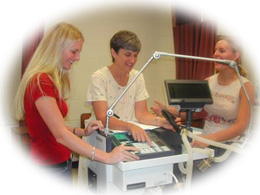Up to 98,000 Americans needlessly die each year in U.S. hospitals, according to a November 1999 Institute of Medicine report. Christine Cannon, Associate Professor, Department of Nursing, is helping mitigate this urgent problem with a tool that helps nursing students deepen their understanding of diseases and disorders.
 The electronic “PATH” chart helps students learn the relationships between disease causes, changes in the body, and the resulting patient symptoms, signs and diagnostic or lab findings.
The electronic “PATH” chart helps students learn the relationships between disease causes, changes in the body, and the resulting patient symptoms, signs and diagnostic or lab findings.
With a 2003 technology assistance grant from PRESENT, Cannon worked with Erin Sicuranza to convert and upgrade the PATH chart worksheet from paper to Microsoft Word. The PATH chart is now available in MyCourses and includes new capabilities and innovative student help tools.
The PATH chart began as a paper form developed by Cannon to help students learn about the causes and effects of common diseases, injuries and disorders. Currently used with NURS241- 242 (campus) and NURS312 (distance) – Pathophysiology, the electronic PATH chart requires each of the approximately 140 students each semester to record their knowledge on the pathology of common diseases such as diabetes and atherosclerosis. “The chart helps students get interested in the whole disease process and actually create something of their own,” says Cannon.
The pathophysiology courses help students learn to assess the underlying processes of a disease by identifying its causes, risk factors, and clinical manifestations. Students then use this information to determine the plan of care for their patients. This is critical, according to Cannon, since nurses are usually the first to discover important changes in a patient’s condition.
 Students develop the Microsoft Word PATH charts for a disease or a group of diseases several times during the semester. They record and interrelate information within and between three columns: Etiology/Risk Factors, Structural/Physiological Alterations, and Clinical Manifestations. “If we’re talking about the immune system, for instance, I’ll have some students complete a PATH chart on immune deficiency, some on immune hypersensitivity, and others on autoimmune diseases,” says Cannon.
Students develop the Microsoft Word PATH charts for a disease or a group of diseases several times during the semester. They record and interrelate information within and between three columns: Etiology/Risk Factors, Structural/Physiological Alterations, and Clinical Manifestations. “If we’re talking about the immune system, for instance, I’ll have some students complete a PATH chart on immune deficiency, some on immune hypersensitivity, and others on autoimmune diseases,” says Cannon.
In addition to reviewing library and textbook resources, the new electronic PATH charts enable students to create links within their charts to medical sites, clinical disease images, and other health care data on the web. With one click, students can access virtually unlimited resources on any disease. They also get the formatting and graphics features of Microsoft Word. “I encourage students to use a flowchart for the disease process,” says Cannon. “It forces them to take this information and make sense of it. And that, I feel, is an important, critical thinking piece.”
Not only does the PATH chart enable these features, but it also provides custom help, thanks to Erin Sicuranza. The moment a student opens the MS Word PATH chart, two floating tool bars appear: The “Path Chart Instructions” toolbar walks students through every step with hints and automated placement of text that they type. The “Path Chart Design” toolbar enables students to insert several types of arrows and modify their colors. The toolbars do not do the work for students, but instead provide help that enables them to concentrate their time on learning the characteristics of a disease.
By mapping disease features, students gain a deeper understanding that helps them respond promptly to clues from patients in the field, says Cannon. “The knowledge of pathophysiology guides nursing students in the assessments of their clients’ health histories, symptoms and clinical signs. These findings are essential for safe and effective patient care. For example, if the student is listening to the heart of a person recently diagnosed with a heart attack, and hears extra heart sounds, he or she would know that this could indicate that excessive blood is accumulating in the heart and that they need to act quickly to treat probable early heart failure. ”
“The electronic PATH charts provide significant educational benefits,” says Cannon. “Students tend to take more time and produce higher-quality charts and engage in more critical thinking. The charts really strengthen the foundation of their understanding of the science of the body,” notes Cannon. “I really like students to get involved, to be thinking and excited about what they are learning. It’s a challenge, especially in a big classroom. Electronic PATH charts are a strong catalyst for learning.”
After surveying students in the spring of 2003, Cannon found that they liked the electronic format. Of the 42 students surveyed, 39 said PATH charting was helpful. Overall, students stated that they like the process of designing the charts with key information and synthesizing it into a “fuller picture” of a disease. They also reported that completing PATH charts helped them retain content, be creative, and find satisfaction and greater competence.
“It encourages students to look beyond their textbooks,” says Cannon, “to think about what they’re reading, and then to translate what they’ve read into their own products. PATH charts help them refine their practice, and in the long run, that should result in better, more efficient care.” With the challenges for nurses today, the PATH chart should be a welcome and helpful tool.